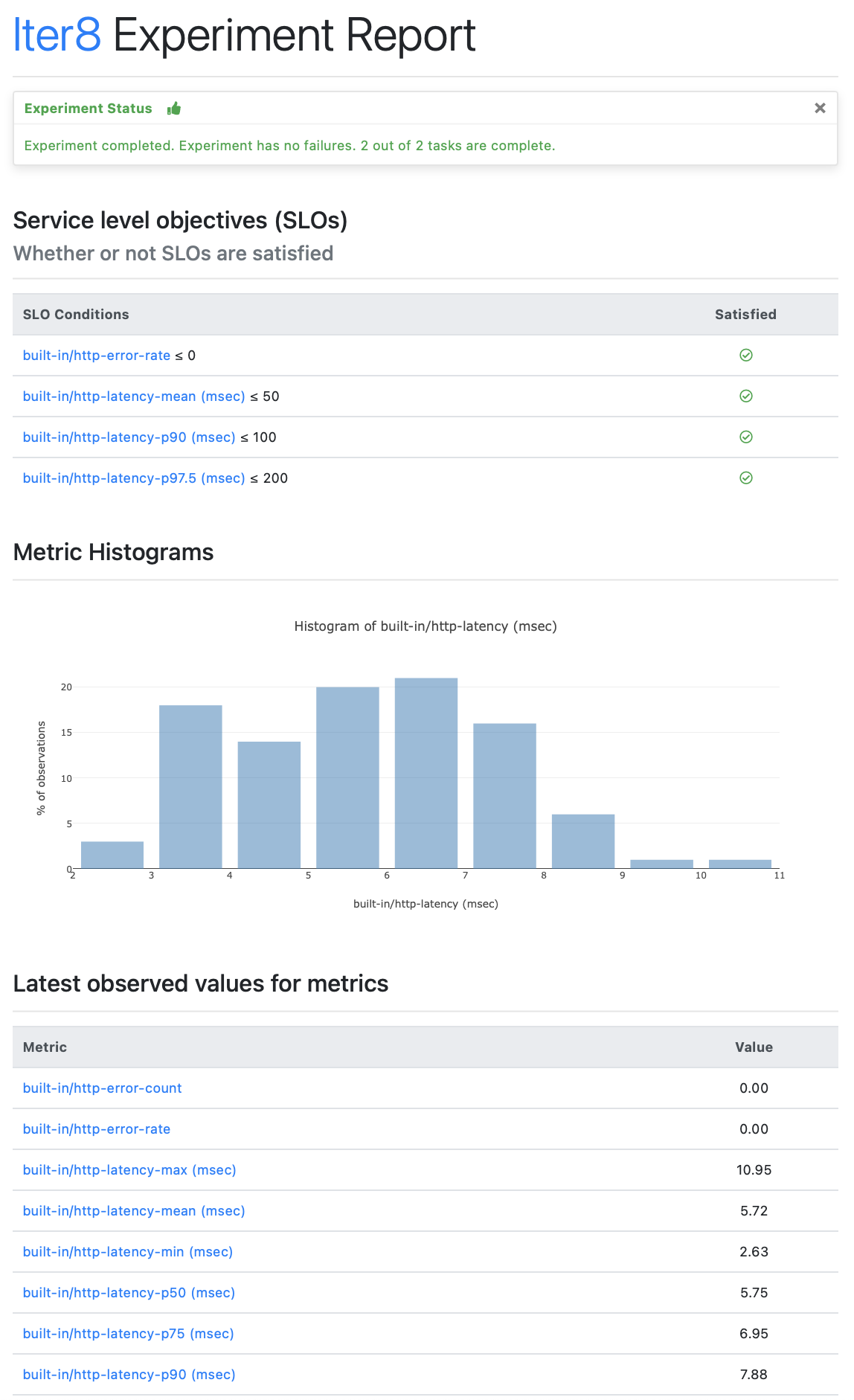Benchmark and Validate HTTP with SLOs¶
The load-test-http experiment generates call requests for HTTP services, collects latency and error-related metrics, and validates service-level objectives (SLOs).

This experiment is designed for the following use-cases.
- Load test
- Benchmark
- Validate service level objectives (SLOs)
- Safe rollout
- Continuous integration and delivery (CI/CD)
Before you begin
Run the httpbin sample service from a separate terminal.
docker run -p 80:80 kennethreitz/httpbin
Basic example¶
Benchmark an HTTP service with a GET endpoint by specifying the url.
iter8 launch -c load-test-http --set url=http://127.0.0.1/get
Metrics and SLOs¶
The following metrics are collected by default by this experiment:
http/request-count: total number of requests senthttp/error-count: number of error responseshttp/error-rate: fraction of error responseshttp/latency-mean: mean of observed latency valueshttp/latency-stddev: standard deviation of observed latency valueshttp/latency-min: min of observed latency valueshttp/latency-max: max of observed latency valueshttp/latency-pX: Xth percentile latency, for X in[50.0, 75.0, 90.0, 95.0, 99.0, 99.9]
Latency metrics have msec units. Any latency percentile that is specified as part of SLOs is also collected.
For example, set the following parameter values in the iter8 launch command above.
--set SLOs.http/error-rate=0 \
--set SLOs.http/latency-mean=50 \
--set SLOs.http/latency-p90=100 \
--set SLOs.http/latency-p'97\.5'=200
In the above setting, the following SLOs are validated.
- error rate is 0
- mean latency is under 50 msec
- 90th percentile latency is under 100 msec
- 97.5th percentile latency is under 200 msec
View experiment report¶
iter8 report
The text report looks like this
Experiment summary:
*******************
Experiment completed: true
No task failures: true
Total number of tasks: 2
Number of completed tasks: 2
Whether or not service level objectives (SLOs) are satisfied:
*************************************************************
SLO Conditions |Satisfied
-------------- |---------
http/error-rate <= 0 |true
http/latency-mean (msec) <= 50 |true
http/latency-p90 (msec) <= 100 |true
http/latency-p97.5 (msec) <= 200 |true
Latest observed values for metrics:
***********************************
Metric |value
------- |-----
http/error-count |0.00
http/error-rate |0.00
http/latency-max (msec) |8.93
http/latency-mean (msec) |5.49
http/latency-min (msec) |2.71
http/latency-p50 (msec) |5.38
http/latency-p75 (msec) |6.71
http/latency-p90 (msec) |7.77
http/latency-p95 (msec) |8.27
http/latency-p97.5 (msec) |8.60
http/latency-p99 (msec) |8.80
http/latency-p99.9 (msec) |8.92
http/latency-stddev (msec) |1.57
http/request-count |100.00
iter8 report -o html > report.html # view in a browser
The HTML report looks like this

Assertions¶
Assert that the experiment completed without failures, and all SLOs are satisfied.
iter8 assert -c completed -c nofailure -c slos
The iter8 assert subcommand asserts if the experiment result satisfies conditions that are specified. If assert conditions are satisfied, it exits with code 0; else, it exits with code 1. Assertions are especially useful inside CI/CD/GitOps pipelines.
Sample output from assert
INFO[2021-11-10 09:33:12] experiment completed
INFO[2021-11-10 09:33:12] experiment has no failure
INFO[2021-11-10 09:33:12] SLOs are satisfied
INFO[2021-11-10 09:33:12] all conditions were satisfied
Load profile¶
Control the characteristics of the load generated by the load-test-http experiment by setting the number of queries (numQueries), the number of queries sent per second (qps), and the number of parallel connections used to send queries (connections).
--set numQueries=200 \
--set qps=10 \
--set connections=5
You can also set the duration of the load generation period. Refer to the chart's values.yaml file for details.
Payload¶
Send any type of content as payload and specify the HTTP Content Type header. These options switch the HTTP method to POST.
Specify payload as a string. By default, its content type is set to application/octet-stream.
--set payloadStr="abc123"
--set payloadStr="abc123" \
--set contentType="text/plain"
Fetch JSON content from a URL. Use this JSON as payload. Set content type to application/json.
--set payloadURL=https://data.police.uk/api/crimes-street-dates \
--set contentType="application/json"
Fetch jpeg image from a URL. Use this image as payload. Set content type to image/jpeg.
--set payloadURL=https://cdn.pixabay.com/photo/2021/09/08/17/58/poppy-6607526_1280.jpg \
--set contentType="image/jpeg"